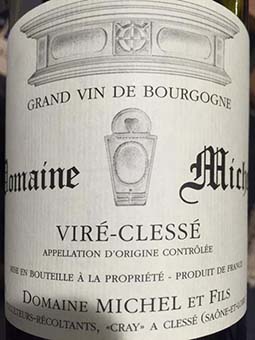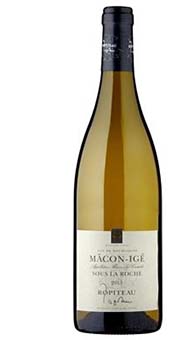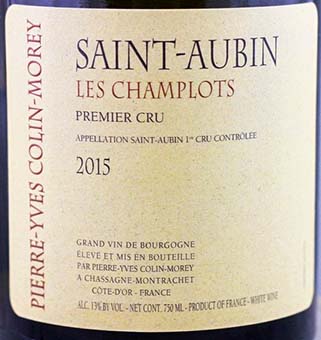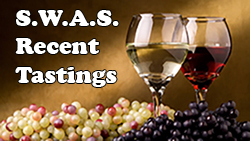Saturday 6th October 2018 : "Classic White Burgundies (with some Reds!)" with Dinah in Lewes.
A very special Tasting with Dinah, the last before she moves house. Her amazing cellar was such a perfect venue...!

The Whites:
1.  Viré-Clessé, Domaine Michel, 2015; 100% Chardonnay; 13.5% abv; Purchased from 'Le Bon Vin', Sheffield for £19.95
Viré-Clessé, Domaine Michel, 2015; 100% Chardonnay; 13.5% abv; Purchased from 'Le Bon Vin', Sheffield for £19.95


Big and ripe, this rich wine offers a good combination of spice and tropical fruits. It is bold, smooth and creamy. Deliciously ripe, it's ready to drink. Great alternative to those who struggle to afford a bottle of Corton Charlemagne! This wine packs a real punch in terms of value and is a great Burgundy Chardonnay. Medium to full-bodied this is a rich, honeyed wine with expressions of exotic fruit and butter.
2.  Mâcon-Igé "Sous la Roche", Ropiteau, 2013; Mâconnais; 100% Chardonnay; Purchased for £25.00
Mâcon-Igé "Sous la Roche", Ropiteau, 2013; Mâconnais; 100% Chardonnay; Purchased for £25.00


The vinification takes place in temperature-controlled stainless-steel tanks for 10 days. The extraction is achieved by the “pumping over” technique. Then follows ageing in stainless-steel tanks for 6 months. The soil made of clay and limestones, gives mineral and tight wines with a lemony flavour that is very characteristic. Elegant, balanced wine with clear notes of flowers, lemon, mint and honeysuckle. This 100% chardonnay has a touch of tarte tatin, revealing subtleties glass after glass.
3.  Saint-Aubin "Les Champlots", Premier Cru, Colin-Morey, 2015; 100% Chardonnay; 13% abv; Purchased for £52.00
Saint-Aubin "Les Champlots", Premier Cru, Colin-Morey, 2015; 100% Chardonnay; 13% abv; Purchased for £52.00


A gorgeous Saint-Aubin by one of its best producers. The wine tingles with racy acidity and savory herbal flavors. The fine line of acidity runs right through the wine and adds to the long finish. Perfect to enjoy now.
4.  Puligny-Montrachat 1er Cru "Les Referts", Vincent Giradin, 2009; Purchased for £52
Puligny-Montrachat 1er Cru "Les Referts", Vincent Giradin, 2009; Purchased for £52


Home to some of the world's most extraordinary Chardonnays including the famous Montrachet, Chevalier-Montrachet and Bâtard-Montrachet, Puligny-Montrachet is the 216 hectare geographical middleman of the white wine villages, bordered by Meursault to the north and by Chassagne-Montrachet to the south. At the bottom of the hillside, « Les Referts » is situated between « Les Perrières » and « Les Charmes » and benefits from an ideal south-easterly exposure.
Pale yellow in colour this Puligny-Montrachet 1er Cru is characterised by a very aromatic and expressive bouquet. It is an elegant wine with lovely length and a touch of mint on the finish. (Tasted December 2011).
SWAS Members felt that the bottle that we tasted, whilst of extremely good quality, had passed its peak by some years.
5.  Maison Dampt Grand Crus Chablis, Bougros, 2013; 100% Chardonnay; 13% abv; Purchased for £36
Maison Dampt Grand Crus Chablis, Bougros, 2013; 100% Chardonnay; 13% abv; Purchased for £36


Vintage 2013 Was a More Complicated Proposition The growing season featured the latest flowering in two decades. The first months of the year featured less sunshine and more precipitation than usual, culminating in a very chilly, wet May. There were already some signs of oidium and mildew on the leaves in some sites by the end of May. The flowering began around June 20 and lasted well into mid-July. Variable weather during this period led to significant coulure (poor set, or shatter) and millerandage (shot berries, or "hens and chicks"), thus reducing the potential size of the crop from the outset. July was then quite warm, even hot during the second half of the month, retarding the veraison. August continued very warm, although temperatures moderated toward the end of the month before spiking up again at the beginning of September. There was regular rainfall during this period. The weather turned cooler and more humid from September 7 through 23, with more showers, and this period brought both maturation of grape sugars and the possibility of some dilution. Under humid conditions, rot pressures continued to build. In the end, the harvest was mostly a race between ripeness and rot. Many growers started picking during the last days of September but some did not start until the beginning of October, as the grapes were not yet ripe. But rainfall on October 4 and 5 totaled 35 to 50 millimeters across the region and rot quickly spread. In retrospect, it’s clear that the ideal window for picking—assuming a particular parcel of vines was ripe—was short: from about September 30 until the rain started on October 4. In that sense, growers on the Côte d’Or had a harvest-time advantage in 2013 as most of them started picking three to five days earlier and were able to bring in their most important vineyards before the rain of early October. On the other hand, Chablis was not affected by the July 23 hailstorm that plagued the Côte de Beaune in ’13.
There are many lovely, easy-drinking wines in 2013 but the vintage style generally trumps the Chablis terroir. Aromatically, the wines typically show an exotic yellow fruit character, with lowish acidity. Sugars levels in the grapes were healthy—and in some cellars a solid 13%. Thanks to the vintage’s generally low yields, the wines tend to be quite concentrated. In light of the incidence of rot, I was pleasantly surprised at how few 2013s from the best addresses show pronounced earthy, truffley or mushroom character from grey rot. But many, if not most, wines show the effects—and early sex appeal—of at least a whisper of noble rot, with their tangy fruit elements of ripe stone and soft citrus fruits complicated by a honeyed quality.
More than one winemaker noted that prior to the early-October rains, the rot was normally dry, and its effects could largely be left behind in the vats. But following the rains, wet rot set in and the grapes rapidly deteriorated. Machine harvesting, which can be a boon to growers in a rush to harvest before inclement weather arrives, was often disastrous in 2013 as the mushy grapes literally fell off the vines before they could be picked due to the vibration of the approaching harvesting machines. And 2013 was an especially tricky year for négociants based outside the region: as they generally spend less time in the vineyards during the summer, they can be less nimble when it comes to making harvest decisions.
6.  Pernand Vergelesses, "Devant les Cloux", Rapet, 2015; 100% Chardonnay; Purchased for £37
Pernand Vergelesses, "Devant les Cloux", Rapet, 2015; 100% Chardonnay; Purchased for £37


Pernand "Devant les Cloux"
Great white Burgundy wine located in the municipality of Pernand - Vergelesses. The variety is Chardonnay, it is new plantings, early 2000s, on new Southwestern well exposed but difficult to work because of steep slope.
"Devant les Cloux" means "In front of the Clos", indeed this climate is in front of Clos Du Bully, old dependency of the abbey of Maizières.
Winemaking in white : We return the grapes in small crates to keep the grapes intact, the pressing is done with a pneumatic press more respectful of the grapes. The whole grapes are placed in the press and the pressing takes two hours. After a 24-hour settling at low temperatures, the grape juice is placed in barrels for fermentation, the proportion of new barrel is 30%. The aging on lees with batonnage lasts until the month of July, the bottling is carried out after 12 months of breeding.
Located on the climate "Front Les Cloux", the hillside is exposed to the South, parallel to the village, the grounds are white, marly, rather light. Rows are short with ditches to contain erosion.
The Pernand-Vergelesses "In front of Les Cloux" attracts the eye with a beautiful color with golden shades, it is fresh, lively and elegant. It exudes a fine nose of fresh fruit, hints of spice as well as traces of honey and gunflint as it matures. Between 3 and 5 years old, it is in its best period, serve it at 12 ° C, it accompanies a fine starter, a goat melt in chaplain, a langoustine stew, prawns, fine fish and blue of Bresse.

The Reds:
7.  Trinity Hill, Syrah, 2015; Hawkes Bay, New Zealand; 100% Syrah/Shiraz; 13% abv; Purchased for £10.95
Trinity Hill, Syrah, 2015; Hawkes Bay, New Zealand; 100% Syrah/Shiraz; 13% abv; Purchased for £10.95



Since its inception in 1993, partners John Hancock, who has been making wine in New Zealand for over 35 years, and Robert and Robyn Wilson, owners of The Bleeding Heart and The Don in London, have made Trinity Hill a byword for quality and consistency. Winemaker Warren Gibson has been with Trinity Hill since 1997. He is also in charge of the 80 hectares of vineyard owned by Trinity Hill, 47 of which are in the Gimblett Gravels and knows the Hawkes Bay and Gimblett Gravels exceptionally well. The wines reflect this, as they characterise the best of what Hawkes Bay can produce. They have an elegance, balance, drinkability and precision of flavour that makes them a joy to sell.
The Syrah grapes were taken from a range of vineyards, including the company owned properties in the Gimblett Gravels region and contracted fruit from the Bridge Pa Triangle. The soils are free draining with low fertility and the vines benefit from prevailing hot, dry westerly winds.
Each individual vineyard parcel was harvested separately with the majority of batches then de-stemmed prior to fermentation. Approximately 15% of the parcels were fermented as whole bunches. Subsequently, gentle daily pumping over of the skins during fermentation helped extract a soft, complex structure. The skin maceration was extended for up to three weeks following fermentation to further integrate and soften the tannins. Following seven months of ageing in a combination of small French oak and stainless steel tanks, the individual blocks were blended to create the ideal marriage of components.
Blackberry, spice and liquorice nuances combine to produce a complex, fruit-dominant wine. The wine is deliberately released at a very youthful age to maximize the beautiful perfume and fruit freshness.
8.  Bila-Haut L'esquerda, Chapoutier, 2015; Cotes du Roussillon Villages; 60% Syrah, 40% Grenache; Purchased for £13.50
Bila-Haut L'esquerda, Chapoutier, 2015; Cotes du Roussillon Villages; 60% Syrah, 40% Grenache; Purchased for £13.50



A cuvée where the quality has increased in just about every vintage, the 2015 Côtes du Roussillon Villages L’esquerda (60/40 Syrah and Grenache) sports a purple/blue color, as well as terrific granite character and minerality in its darker fruits, violets and spring flower-scented bouquet. Full-bodied, focused, concentrated and balanced, it has a pure, precise style that will evolve nicely for a decade ago. Like with a number of other cuvées, this 2015 is easily the best yet.
9.  Gran Passione Rosso " Baby Amarone", 2017; Veneto, Italy; Merlot/Corvina blend; 14% abv; Purchased for £11.95
Gran Passione Rosso " Baby Amarone", 2017; Veneto, Italy; Merlot/Corvina blend; 14% abv; Purchased for £11.95



If you want a taste of the Amarone experince without the heady price tag, Gran Passione certainly delivers, made using the same traditional “Apassimento” method, its full bodied blend of Merlot & Corvina is rich & overflowing with lusciously sweet & soft black cherry, vanilla & plum, the velvet soft tannins make it effortlessly drinkable, with or with out food, game dishes are the way to go with gran passione.
SWAS Cellar Wine:
 The Wine Society's Exhibition Hermitage Rouge 2005 from the Rhône Valley, France; originally purchased by the SWAS Fine Wine Committee in Feb 2016 for £36 and now deemed by the Wine Society to be in its prime and ready to be tasted...!
The Wine Society's Exhibition Hermitage Rouge 2005 from the Rhône Valley, France; originally purchased by the SWAS Fine Wine Committee in Feb 2016 for £36 and now deemed by the Wine Society to be in its prime and ready to be tasted...!


This wine, as before, was superb, Bryan described and served it after careful decantering and it was unanimously appreciated.

For Supper, Dinah served Monk Fish and Prawns in a Tomato Sauce with Green Beans and Boiled Rice followed by a Cinnamon, Nutmeg, Walnut Apricot Pie with Ice Cream. We finished with an extensive Cheese Board.

The Raffle:
1. .png) Weingut Winter Reisling Trocken 2016 - won by Alex
Weingut Winter Reisling Trocken 2016 - won by Alex


2.  Nero d'Avola, Vendemmia, 2015 - won by Bill
Nero d'Avola, Vendemmia, 2015 - won by Bill



.jpg)
Sue, Janis and Bill were totally oblivious as Frank mopped up the remains of our Supper...!

